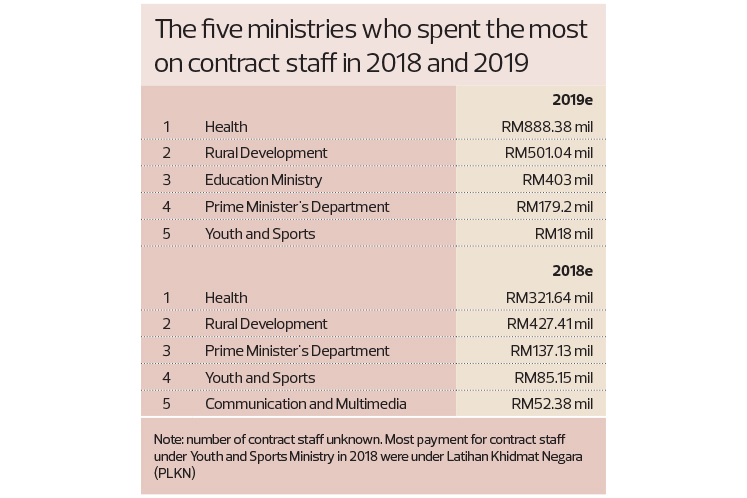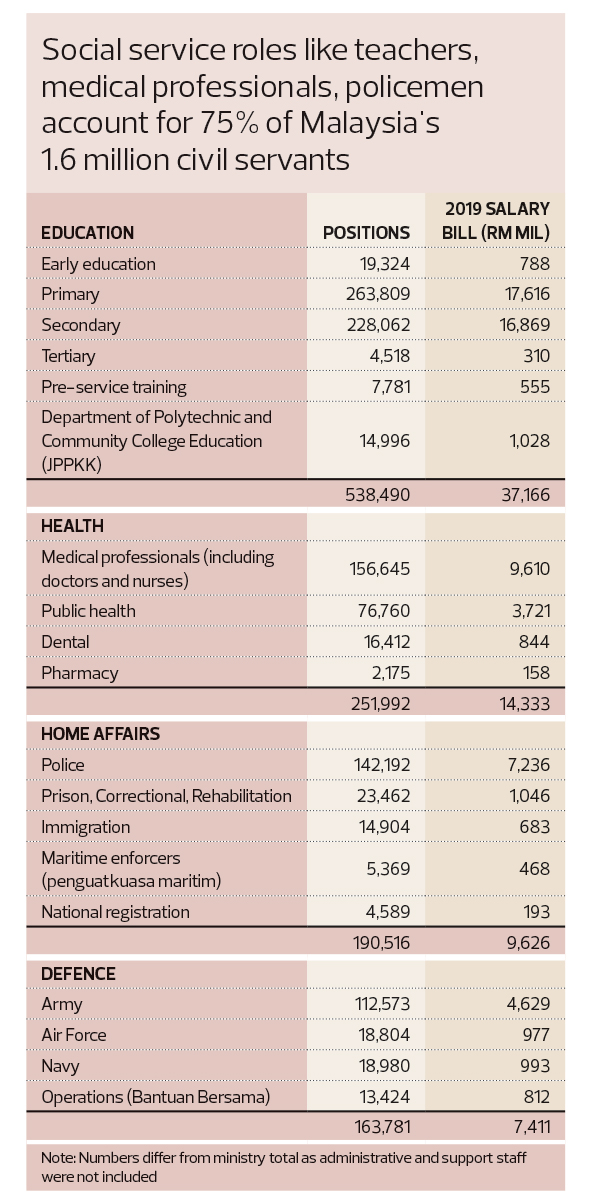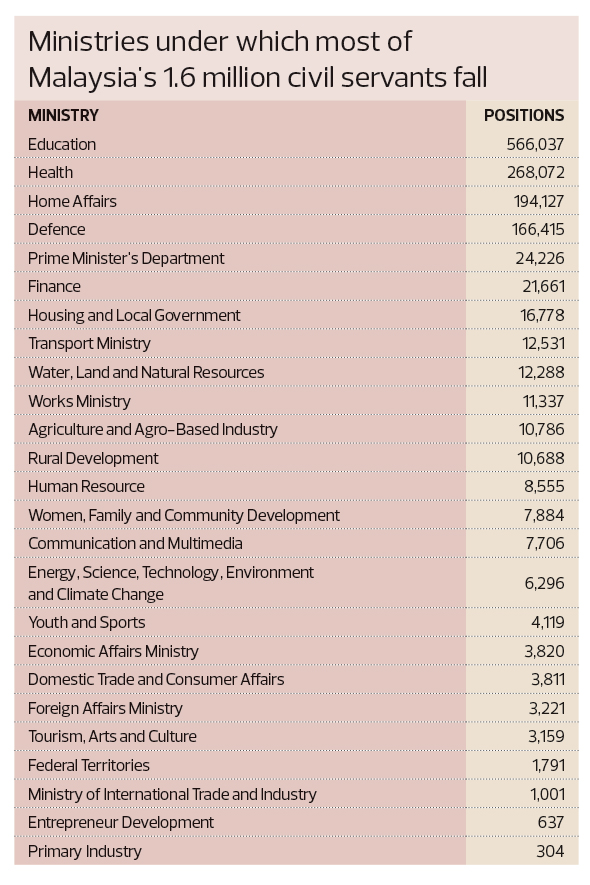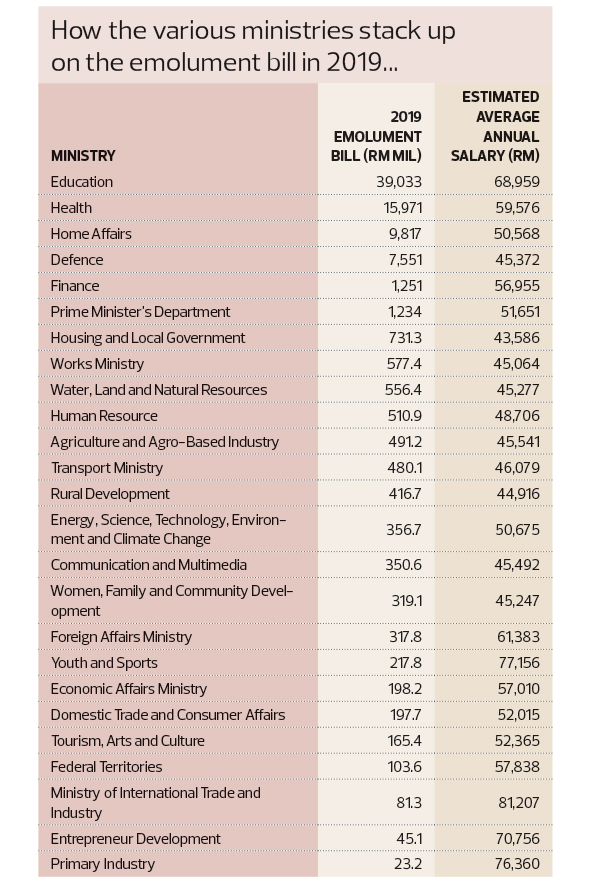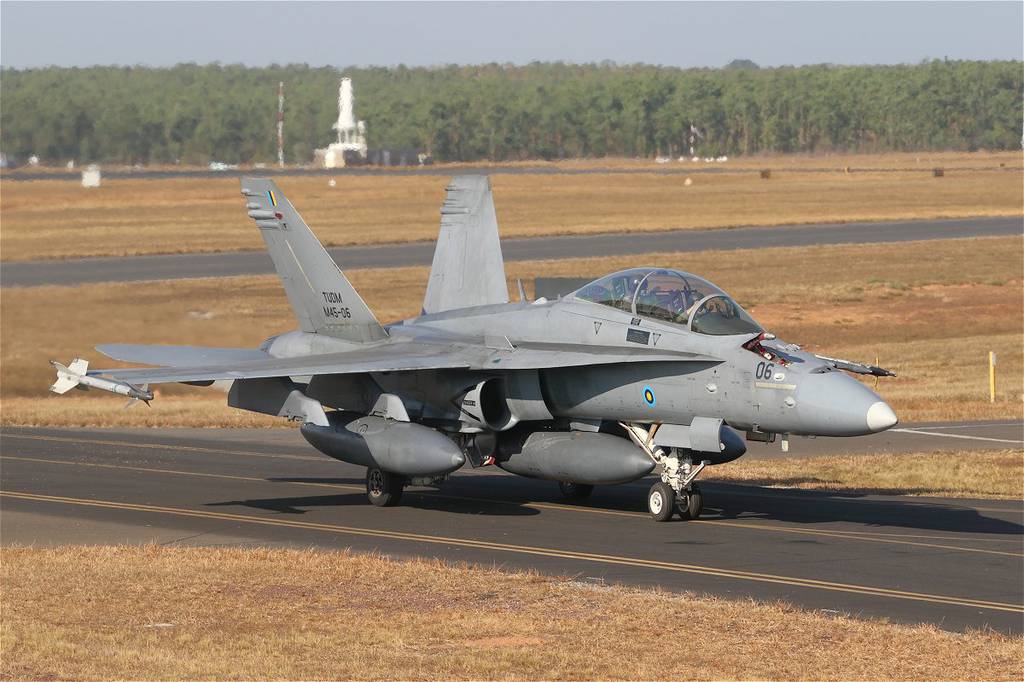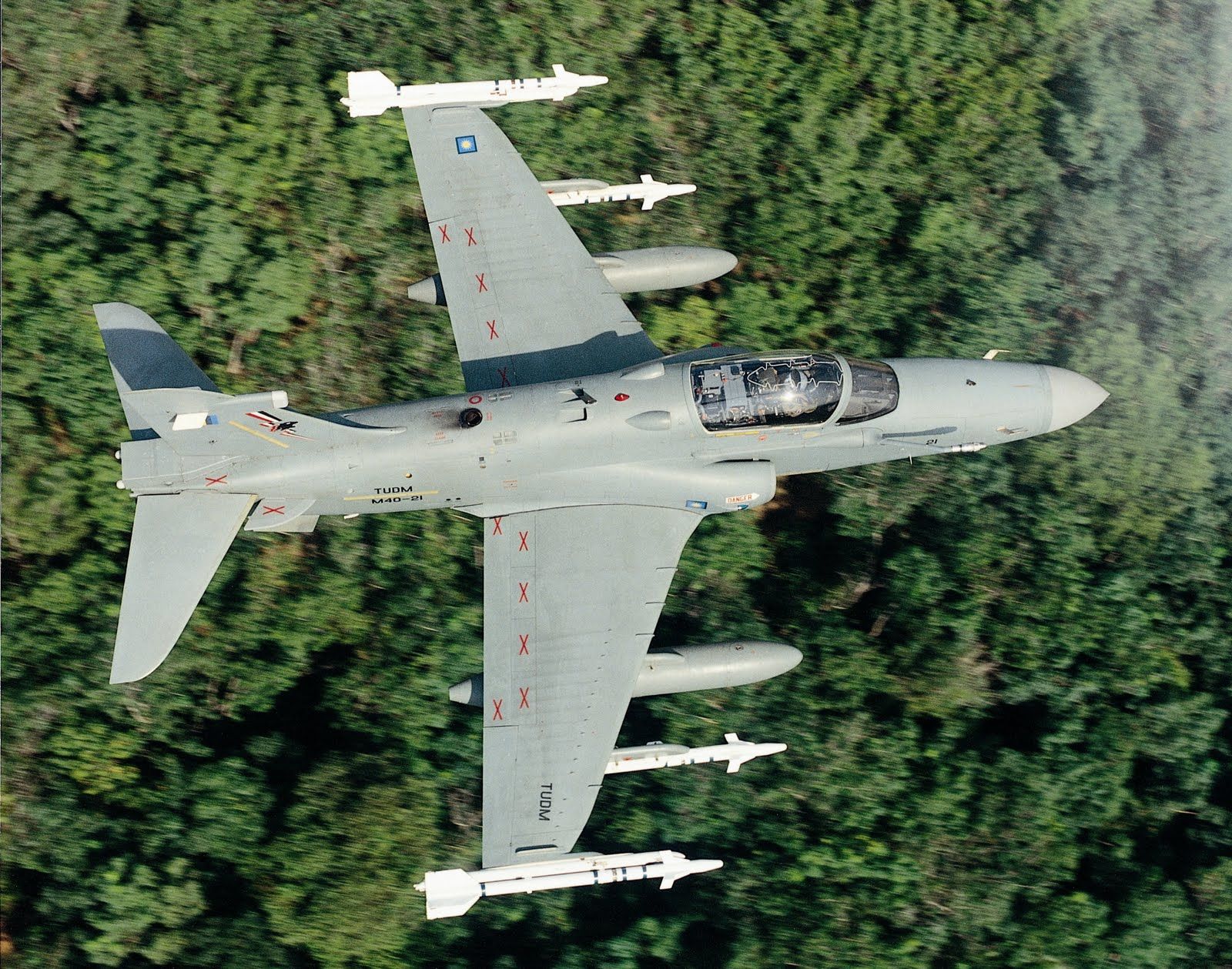Found an article in 2019, posted here.
Cover Story: Can the civil service be downsized?
Cindy Yeap
The Edge Malaysia
October 03, 2019 16:00 pm +08
This article first appeared in The Edge Malaysia Weekly, on September 23, 2019 - September 29, 2019.
Click / Tap image to enlarge
Click / Tap image to enlarge
Click / Tap image to enlarge
MALAYSIA needs to trim the civil service by one million employees to 600,000 to reach South Korea’s 1:50 civil service-to-population ratio. That’s impossible unless the 640,000 teachers, doctors and nurses in the country are not counted as civil servants, data from the Ministry of Education (MoE) and Ministry of Health (MoH) show.
The RM55 billion required to remunerate the 834,109 civil servants at the MoE and MoH alone accounts for 67% of the country’s RM82.045 billion emolument bill for 2019, expenditure details from the Ministry of Finance show.
Immigration officials, the police and the army — who fall under the Home Ministry — account for 300,000 civil servants and a RM15 billion salary allocation. Together with teachers and medical personnel, these frontline service personnel make up about one million civil servants, nearly two-thirds of Malaysia’s 1.6 million-strong civil service. Most of them have key roles but technology advancement means that these employees will need to be retrained for new roles.
It remains to be seen if prisons and correctional facilities — where there are 23,462 civil servants who will be paid more than RM1 billion this year — can be privatised or corporatised into a real estate investment trust (REIT), something that has been done overseas.
It will be hard to reduce the civil service to one million people — the size when Tun Dr Mahathir Mohamad ended his first tenure as prime minister in 2003 — which would improve the civil service-to-population ratio to 1:32 from the current 1:20, which is reportedly among the highest in the world. The ratio is reportedly 1:71 for Singapore and 1:11 for Indonesia.
A more likely working figure for Malaysia in the medium term is perhaps 1.3 million, a 300,000 reduction that would bring the ratio back to the 1:25 reported in 2003 when the country’s population was 25 million. Today, the population stands at 32.58 million (including 3.2 million non-Malaysians).
The government has said it will not expand the civil service and is considering privatisation to reduce the civil service emoluments bill. It cannot allow the civil service emoluments and pension bill to increase at previous rates. If government revenue can somehow rise more than 10% a year, the government could well be able to continue paying the emoluments and pension bill, simple projections based on earlier 10-year compound annual growth rate (CAGR) assumptions show. Yet, the government may still be in a deficit situation with limited fiscal muscle if its other expenses rise faster. The current 10-year CAGR for revenue is less than half of what is required, at only 3.87% per annum.
50% income on 7.5% population
In 2003, the civil service wage bill was RM21.72 billion, 23.4% of government revenue. It ballooned in the past decade from 27% of government revenue in 2009 to 35.4% of normalised government receipts this year. The absolute amount doubled in the past decade from RM42.8 billion in 2009 to RM82.04 billion this year, which is larger than the entire company income tax receipt of RM70.2 billion.
Altogether, including pensions and gratuities, 47% of government revenue has been spent this year. In other words, nearly half of government revenue has already been spent on part of public service delivery and just 7.5% of the country’s population, given that there are 1.6 million civil servants and 834,000 pensioners and beneficiaries in 2019.
Emoluments and pensions and gratuities were just under 30% of government revenue in 2003.
Pensions and gratuities payment to civil servants and their dependants, which was already rising as baby boomers retired, spiked 22.7% year on year to RM18.2 billion in 2014, just after the government instituted an automatic 2% annual pension hike in 2013 without needing to wait for any salary review.
A review of the current defined benefit model for public pensions is also long overdue to ensure sustainability, especially as the population ages and Malaysians live longer.
Incidentally, the youngest of the baby boomers (those born between 1944 and 1964) will reach the age of 55 this year. As the retirement age was moved from 55 to 60 on July 1, 2013, all baby boomers will only reach the official retirement age in 2024. The oldest among Generation X (those born between 1965 and 1979) will turn 55 next year, reaching the current retirement age of 60 in 2025. The younger Gen X and the generations after it will likely be more pressured over retirement savings compared with the baby boomers, given that asset price inflation only skyrocketed following the era of global cheap money after the global financial crisis.
In March, Finance Minister Lim Guan Eng said Dr Mahathir would make the announcements relating to the privatisation of the civil service or roles when the time came.
Lim also said the privatisation of some civil service roles will not result in civil servants losing their jobs, noting how workers were absorbed into the corporatised Telekom Malaysia Bhd in the 1980s. The civil service might have another 100,000 employees today if it were to include the work force of Telekom, Tenaga Nasional Bhd, Malaysia Airlines Bhd and Petroliam Nasional Bhd.
It remains to be seen if the consolidation of roles, agencies and, perhaps, even ministries, as speculated with the Cabinet reshuffle, will free up the government’s fiscal space for more productive spending, which is necessary to ensure that Malaysia continues to have strong fundamentals to support the economy.
So far, Dr Mahathir has been talking down expectations of generous salary adjustments for civil servants in the Pakatan Harapan government’s second national budget, relating how the country is now paying for the past government’s largesse to “buy the loyalty of civil servants” by “cutting down on development”. In July last year, the new government halted a civil servant pay hike promised by the previous government that would have cost some RM1.5 billion.
Can the 300,000 positions be found?
Some excesses have been cut by eliminating “non-essential bodies” that Dr Mahathir said had been set up by the previous government to pay loyalists “huge salaries that could reach tens of thousands of ringgit” every month. The current government says it cannot afford to pay those salaries.
Allocations for several agencies that were cut soon after the current administration took over in May last year amounted to more than RM440 million, a back-of-the-envelope calculation shows. These agencies include the Land Public Transport Commission (SPAD), whose duties have been taken over by the Transport Ministry. SPAD was allocated RM40 million in 2017 as well as 2018 (previous administration), none of which was listed under emoluments under the federal government expenditure estimates but was counted under grants and transfers.
Other agencies that were reportedly consolidated or cut include the National Professors Council (MPN), the Malaysian External Intelligence Organisation (MEIO), the Special Affairs Department (Jasa), the Residents’ Representatives Committee (JPP) and the Village Development and Security Committee (JKKK).
JKKK and JKKKP were originally allocated RM303.89 million in grants and transfers for 2018 under the Ministry of Rural Development.
Some may recognise MEIO — formally known as the Research Division of the Prime Minister’s Department — as the little-known spy agency that made the headlines in August last year after the leaking of a letter dated May 4, 2018, by former head Datuk Hasanah Abdul Hamid to the US’ Central Intelligence Agency (CIA) director Gina Haspel appealing for the US’ support for former prime minister Datuk Seri Najib Razak’s administration.
The Research Division, which came under security management, was allocated RM60.47 million for 2017 and 2018 (previous administration), of which RM46.53 million was for emoluments for 321 positions. This works out to an average salary of RM144,938 a year or RM12,078 per month. Meanwhile, MPN, which was also under the Prime Minister’s Department, was allocated RM8.6 million for 2018.
Disbanded on Oct 15, 2018, Jasa was under the Ministry of Communications and Multimedia and allocated RM30.02 million in 2018, of which RM12.85 million was for emoluments for 272 positions and the rest for supplies and services. Some 300 civil servants under Jasa were reportedly redeployed while 800 officials under contract were terminated.
It remains to be seen how many more agencies can be cut going forward and how much savings can be obtained.
At 94, Dr Mahathir may well be the only Malaysian politician who does not have to fear that a necessary move involving the civil service will be “political suicide”.
The 14th Malaysian parliament, which convened under the Pakatan Harapan government on July 16, 2018, will sit for five years if it is not dissolved earlier. A general election must be held within 60 days of its dissolution. That means GE15 must be held by mid-September 2023. By then, Dr Mahathir — who was first sworn in as prime minister at the age of 56 on July 16, 1981 — would be 98. That’s 27 years more than the average life expectancy of 70.8 years for a bumiputera male in Malaysia.
With the meeting of two election promises — lowering the voting age to 18 and automatic registration of eligible voters — a new group of voters has been created. About 22.74 million Malaysians will be eligible to vote in GE15 — including 7.8 million new voters who will be automatically registered over the next five years — thanks to the passing of Constitution (Amendment) Bill 2019 in parliament on July 16. The new voters include 3.9 million youth aged 21 who have yet to register as voters.
In GE14 (May 9, 2018), the turnout was 82.32% of 14,940,624 registered voters.






